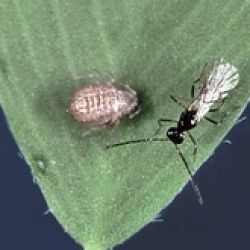Aphid parasitoids

Trioxys complanatus wasp and aphid 'mummy'
© Queensland Government
Several wasp species parasitise aphids. They are small and difficult to see in the field, so aphid 'mummies' are usually used as evidence of wasp presence.
Scientific name
Aphidius colemani
Aphidius ervi
Trioxys complanatus
Description
Adults:
- small dark wasps
- 2–3mm long
- clear wings
- long antennae.
Buff-coloured aphid mummies develop as the wasp larvae grows within the aphid host.
Hosts
L. testaceipes attacks cotton aphid, corn aphid and cowpea aphid.
A. colemani attacks cotton aphid, green peach aphid, turnip aphid and oat aphid.
A. ervi attacks blue green aphid and pea aphid.
T. complanatus attacks spotted alfalfa aphid.
Impact on pests
Aphid parasitoids can have a major impact on aphid populations.
Life cycle and ecology
Female wasps insert an egg into the aphid and the developing larvae feeds inside the aphid, eventually killing it.
Parasitised aphids take up to 10 days to develop into 'mummies'.
The adult wasp emerges from the mummy by cutting a circular exit hole in the skin.
Factors that influence effectiveness
The time taken for the 'mummy' to develop can lead to the wasp's impact being underestimated due to initially parasitised aphids looking like unaffected aphids.
Wasp sensitivity to pesticides varies. Consider the potential impact on beneficial populations when making pest control decisions.
Further information
- Aphidius sp.—Goodbugs.org.au
- Aphid parasitoids—Cesar PestNotes
- Parasitoid wasp laying her egg in an aphid (video)—The Beatsheet
- Adult parasitoid emerging from an aphid mummy (video)—The Beatsheet
- Pesticide impact on wasps is available using the insecticide impact table in the latest Cotton Pest Management Guide—CottonInfo